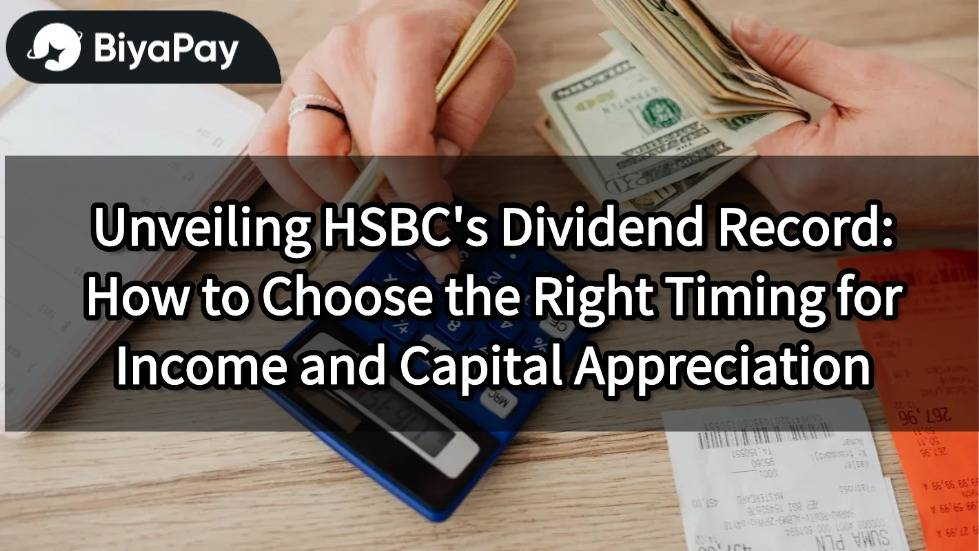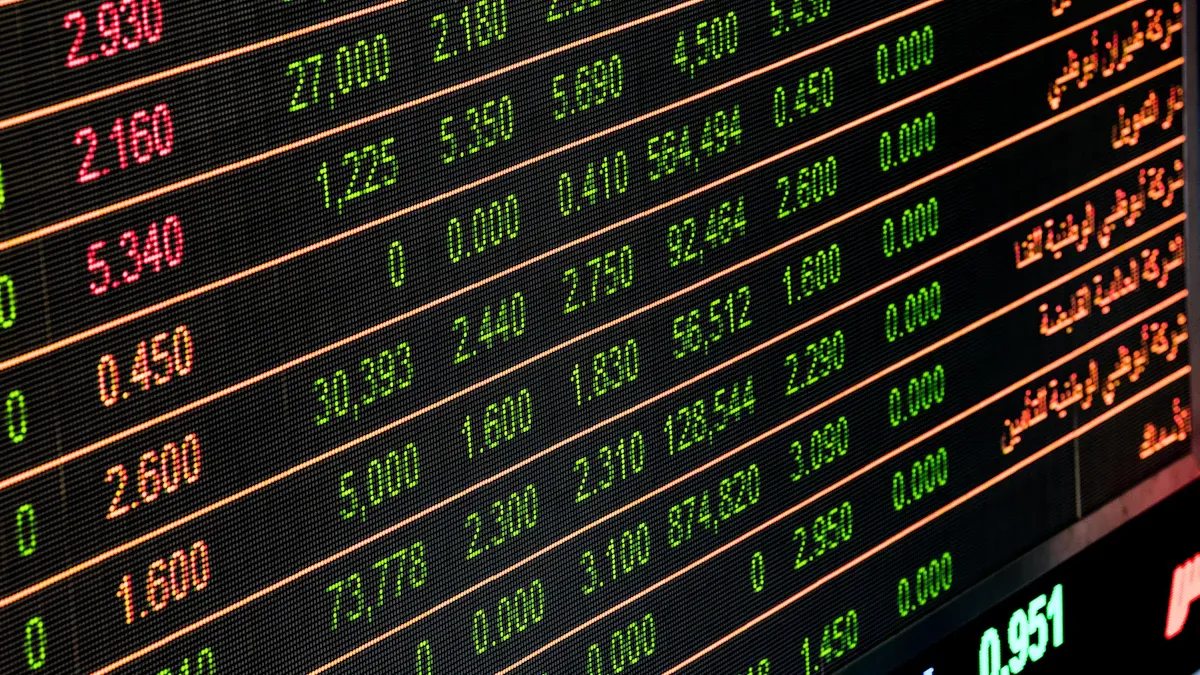- EasyCard
- Trade
- Help
- Announcement
- Academy
- SWIFT Code
- Iban Number
- Referral
- Customer Service
- Blog
- Creator
Unveiling HSBC's Dividend Record: How to Choose the Right Timing for Income and Capital Appreciation

Image Source: pexels
Do you often want to find a stable income higher than Hong Kong bank fixed deposits? HSBC’s dividend record has always been highly regarded by investors. You can utilize this stable dividend to achieve long-term capital appreciation while also enjoying cash flow. As long as you choose the right timing, buy in batches, and manage portfolio allocation well, you can enhance the income effect. Many investors hope to balance capital appreciation and income, and you can achieve this goal with this method.
- Remember, long-term holding often reduces risks brought by market volatility.
- A wise strategy allows you to collect dividends while also seeing asset growth.
Key Points
- HSBC’s dividend record is stable, and long-term holding can bring stable cash flow and capital appreciation.
- The dividend yield is higher than bank fixed deposits, suitable for investors seeking stable income.
- Before investing, analyze the company’s fundamentals and dividend policy to avoid high-risk traps.
- Staggered buying and diversified portfolio allocation can reduce risks and improve investment success rates.
- Pay attention to transaction costs and market volatility, and periodically adjust your holding strategy to maintain stable returns.
HSBC Dividend Record

Image Source: pexels
Stability
If you want stable income, HSBC’s dividend record is an important reference indicator for you. Over the past 20 years, HSBC has maintained dividends every year, only pausing in rare special circumstances. For example, in 2020, due to the global pandemic and regulatory requirements, HSBC briefly suspended dividends but quickly resumed. You can see that HSBC’s dividend record demonstrates strong continuity. This stability gives you more confidence when planning long-term investments. You don’t need to worry about the company suddenly stopping dividends, which is very important for investors pursuing cash flow.
Tip: You can use HSBC’s dividend record to build confidence in long-term income and reduce anxiety caused by market volatility.
Dividend Yield
When choosing income stocks, the dividend yield is a key indicator for you. HSBC’s dividend record shows that its dividend yield is usually higher than Hong Kong bank fixed deposits. For example, in 2024, HSBC’s projected full-year dividend yield is expected to exceed 8% (approximately 8%), far higher than the 2% to 3% of Hong Kong bank fixed deposits. If you calculate using an exchange rate of 1 USD to 7.8 HKD, HSBC’s annual dividend per share is about 0.6 USD, which is significantly advantageous compared to similar financial stocks.
You can refer to the following comparison:
- The dividend yield of preferred shares among financial stocks is about 4.1%.
- Cathay Financial’s Class A preferred shares have a market value of about 4.6 billion USD, higher than the 3.6 billion USD of common shares.
- Preferred shares, due to their higher dividend yield, are favored by government funds and insurance companies.
These data show that HSBC’s dividend record is not only stable but also competitive in terms of dividend yield. If you want stable income, HSBC is a choice worth considering.
Influencing Factors
Performance and Financial Reports
When observing HSBC’s dividend record, you should first look at the company’s performance and financial reports. HSBC publishes financial reports annually, which include important data such as revenue, net profit, and balance sheets. If the company’s profits are stable, its dividends will naturally be stable. You can pay special attention to the payout ratio (i.e., the proportion of profits used for dividends). If the payout ratio is too high, it may mean the company is using most of its profits for dividends, which could increase the risk of unstable dividends in the future. You should also note the company’s debt level, as excessive debt can affect cash flow and, consequently, dividend capacity.
Interest Rates and Economy
You also need to pay attention to interest rates and the economic environment. When the U.S. federal funds rate rises, Hong Kong banks’ fixed deposit rates will also adjust accordingly. At this time, HSBC’s dividend attractiveness may decrease because investors will compare the returns of fixed deposits and dividends. The economic environment also affects HSBC’s dividend record. If the global economy is sluggish, banks’ profitability may decline, and dividends may decrease. You can use the USD to HKD exchange rate (e.g., 1 USD to 7.8 HKD) to calculate actual returns, making it easier to compare returns from different investment tools.
Dividend Policy
You also need to understand HSBC’s dividend policy. The company adjusts its dividend strategy based on profitability, regulatory requirements, and market conditions. For example, in 2020, due to regulatory requirements, HSBC suspended dividends temporarily. You should regularly follow company announcements to stay updated on the latest dividend policies. This way, you can avoid high-yield traps and not overlook potential risks due to temporary high dividend yields.
Tip: When choosing income stocks, besides looking at the dividend yield, you should also assess the company’s financial health and dividend policy to ensure stable long-term income.
Historical Performance
Stock Price Volatility
When investing in HSBC, you will notice that the stock price often fluctuates. Whenever the company announces dividend news, the stock price usually reacts significantly. For example, before a dividend announcement, many investors buy stocks hoping to receive dividends, which may cause the stock price to rise. After the ex-dividend date, the stock price may sometimes fall due to ex-dividend adjustments. If you only focus on short-term prices, you may feel uneasy. In fact, HSBC’s dividend record shows that long-term holding is more effective at reducing the stress caused by volatility than short-term trading. As long as you extend your holding period to five years or more, the impact of these short-term fluctuations will diminish.
Tip: You can use a long-term holding strategy to accumulate dividend income and offset the risk of short-term price drops.
Long-Term Potential
If you want to achieve both income and capital appreciation with HSBC, you must understand its long-term potential. HSBC’s return on assets (ROA) and return on equity (ROE) are relatively low, indicating that the company focuses on stable dividends with limited stock price growth potential. You can refer to the following multi-year growth data from global markets to compare the long-term performance of different assets:
- U.S. S&P 500 companies’ earnings growth rate in 2024 is about 10.7%, with an estimated 14.2% in 2025.
- U.S. GDP is estimated to grow by 2.7% in 2024 and 1.9% in 2025.
- Generative AI is expected to have a compound revenue growth rate of about 42% over the next 10 years.
- The global cloud market is projected to have a compound growth rate of about 13.81% from 2023 to 2027.
You will find that HSBC’s dividend record is suitable for those seeking stable cash flow. If you want higher capital appreciation, you may need to consider allocating some growth-oriented assets. You can treat HSBC as an income cornerstone and pair it with other high-growth industries to make your overall portfolio more balanced.
Buying Timing

Image Source: pexels
Fundamentals
When considering HSBC’s dividend record, you should start with fundamentals. Fundamental analysis can help you determine whether the company is worth long-term investment. You can begin with the following steps:
- Balance Sheet Analysis
You should examine the company’s asset structure, debt levels, and shareholders’ equity. Metrics like the current ratio, debt-to-asset ratio, and equity ratio can help you assess the company’s financial risks and capital condition. - Income Statement Analysis
You can observe the revenue structure, gross margin, net margin, and profit growth rate. These data reflect the company’s profitability and competitiveness. - Cash Flow Statement Analysis
You should focus on operating, investing, and financing cash flows. Stable cash flow indicates the company’s ability to sustain dividends. - Financial Ratio Analysis
You can calculate return on assets, capital structure ratios, and current ratios. These ratios comprehensively assess the company’s profitability, debt repayment capacity, and operational efficiency. - Trend and Peer Analysis
You can compare the company’s financial data across different years and conduct peer comparisons with industry competitors. This gives you a more comprehensive understanding of the company’s financial health.
Tip: When analyzing HSBC’s dividend record, pay special attention to the payout ratio and cash flow, as these two metrics directly affect the company’s ability to sustain dividends.
Technical Analysis
In addition to fundamentals, you should also learn technical analysis. Technical analysis can help you determine the entry timing and improve buying success rates. You can use the following methods:
- Observe historical stock price trend charts to identify the main price trends.
- Use technical indicators like Moving Averages (MA), KD, RSI, MACD to determine if the stock price is at a relative low.
- Combine volume changes to confirm the validity of buy signals.
You can refer to this table to understand the buying strategies for different volume-price characteristics:
| Volume-Price Characteristics | Buying Strategy Description |
|---|---|
| Mild volume increase in early uptrend | Build positions gradually |
| Volume surge in early uptrend | Build positions gradually |
| Low-price zone with shrinking volume and rising price | Be cautious, potential pullback |
| Sideways with shrinking volume in early uptrend, volume breaks through moving average | Wait for volume to break moving average to buy |
| Volume surge in mid-uptrend | Build positions gradually, potential for significant rally |
| Shrinking volume in mid-uptrend, short-term moving average golden cross | Technical buy signal |
| Shrinking volume with consecutive negative candles in mid-uptrend, not breaking 30-day MA | Technical support buy |
| Shrinking volume in mid-uptrend, supported by 60-day MA | Technical support buy |
| Continuous volume surge in late uptrend | Beware of trend reversal, avoid chasing highs |
| Shrinking volume in late uptrend | Decisively stop loss and exit |
| Continuous volume surge with stagnant price in late uptrend | Exit and observe |
| Cross star at high levels | Hold cautiously, potential trend change |
You can see that technical analysis not only looks at price but also combines volume and moving average signals. When the stock price shows mild volume increases in the early uptrend, building positions gradually is a safer strategy. If there is continuous volume surge with stagnant prices or a cross star at high levels, stay vigilant to avoid chasing highs.
Technical analysis believes that price trends reflect all information. You can use past price and volume changes to predict future trends. It’s recommended to focus on 1-2 indicators and continuously review and adjust.
Staggered Buying Suggestion
In actual operations, staggered buying can effectively reduce volatility risks. Many investors divide their capital into 3 to 5 portions and enter the market monthly. This strategy allows you to average costs across different price ranges, reducing the pressure of one-time entry. According to public performance data, staggered buying strategies are effective for investors with different capital scales. You can focus on your main business, invest idle funds, manage capital well, and find suitable cycles and low-entry opportunities.
Tip: You don’t need to predict the lowest point; as long as you buy in batches, you can smooth costs over time and improve investment success rates.
By combining HSBC’s dividend record, fundamental, and technical analysis, you can choose entry timing with more confidence. This way, you can not only achieve stable income but also balance capital appreciation.
Holding Strategy
Staggered Entry
When investing in HSBC, you can consider staggered entry. This method helps you spread risks and reduce the pressure of one-time investments. According to a study of 1,021 rolling investment periods in the U.S. market, the loss rate for staggered entry is 17.6%, significantly lower than 22.4% for lump-sum investments. This shows that staggered entry effectively reduces loss risks. You can refer to the following scenarios to decide if staggered entry suits you:
- Want to minimize downside risks
- Hope to use market volatility to lower holding costs
- Don’t want to bear the psychological burden of immediate price drops after buying
When entering in batches, you can divide your capital into 3 to 5 portions and invest monthly or quarterly. This way, even with short-term market fluctuations, you can use cash positions to defend and reduce overall portfolio risks. Although staggered entry may yield slightly lower long-term returns than lump-sum investments, it’s a prudent strategy for those with lower risk tolerance.
Portfolio Allocation
When building an income portfolio, it’s advisable not to hold only HSBC stock. You can choose Hong Kong stocks with different dividend months, such as HKEX or CLP Holdings, to ensure monthly cash inflows. Such a portfolio can smooth income and reduce risks from a single company or industry. You should also periodically review your portfolio and adjust holdings based on market changes or company fundamentals. For example, when a stock’s dividends decrease or performance weakens, you can reduce exposure and increase stable income stocks.
Tip: You can use a table to track each stock’s dividend months and estimated dividends to plan monthly cash flow.
Transaction Costs
When investing for income, you cannot ignore transaction costs. Common costs include custody fees and dividend collection fees. For Hong Kong brokers, custody fees are about 0.5 to 1 USD per month, and dividend collection fees range from 0.5 to 2 USD per dividend payment. When your holdings or dividends are small, these fees may erode your actual returns. You can use the table below to compare the impact of different costs on returns:
| Item | Fee Range (USD) | Description |
|---|---|---|
| Custody Fee | 0.5-1/month | Charged monthly |
| Dividend Collection Fee | 0.5-2/time | Charged per dividend payment |
| Transaction Fee | Varies by broker | Charged once per trade |
Before investing, calculate expected dividends and related fees to ensure actual returns meet your goals. Choosing a low-cost broker can also improve your income efficiency.
You can leverage HSBC’s stable dividend record, combined with staggered buying and diversified portfolio allocation, to build a long-term income strategy. You should periodically review market and company conditions and flexibly adjust holding proportions. When investing in HSBC income stocks, pay attention to both returns and risks. As long as you establish the right income mindset and use these techniques, you can improve your investment success rate.
FAQ
How often does HSBC pay dividends?
You can receive HSBC dividends four times a year. The company typically announces dividend amounts and dates after each quarter ends. You can check the company’s official website or broker platform for the latest information.
Are HSBC dividends affected by exchange rates?
The dividends you receive are calculated in USD. If you use a HKD account, the bank will automatically convert based on the exchange rate at the time (e.g., 1 USD to 7.8 HKD). Exchange rate fluctuations will affect the actual amount received.
What are the risks of investing in HSBC for income?
You should pay attention to the company’s performance, economic environment, and regulatory policies. If the company’s profits decline or it encounters special events, dividends may decrease or be suspended. Stock price volatility can also affect your capital.
What are the costs of trading HSBC stocks?
You need to pay transaction fees, custody fees, and dividend collection fees. For Hong Kong brokers, custody fees are about 0.5 to 1 USD per month, and dividend collection fees are about 0.5 to 2 USD per dividend payment.
What are the benefits of staggered buying of HSBC?
Staggered entry allows you to average costs and reduce the risk of one-time buying. Even with short-term fluctuations, you can reduce losses and improve long-term investment success rates.
HSBC’s robust dividend history (~8% yield in 2024) offers steady income, but stock volatility and trading costs challenge returns. BiyaPay empowers you to maximize gains with a single account for trading US/HK stocks and cryptocurrencies, no offshore accounts needed. Convert USDT to USD or HKD with real-time exchange rates to minimize dividend conversion losses, with transfer fees as low as 0.5%, outperforming traditional brokers.
Backed by FinCEN and FINTRAC licenses, BiyaPay ensures secure trading. Sign up in minutes to time your investments effectively. Join BiyaPay now to boost income and growth! Trade with BiyaPay today and conquer market volatility!
*This article is provided for general information purposes and does not constitute legal, tax or other professional advice from BiyaPay or its subsidiaries and its affiliates, and it is not intended as a substitute for obtaining advice from a financial advisor or any other professional.
We make no representations, warranties or warranties, express or implied, as to the accuracy, completeness or timeliness of the contents of this publication.




Contact Us
Company and Team
BiyaPay Products
Customer Services
is a broker-dealer registered with the U.S. Securities and Exchange Commission (SEC) (No.: 802-127417), member of the Financial Industry Regulatory Authority (FINRA) (CRD: 325027), member of the Securities Investor Protection Corporation (SIPC), and regulated by FINRA and SEC.
registered with the US Financial Crimes Enforcement Network (FinCEN), as a Money Services Business (MSB), registration number: 31000218637349, and regulated by FinCEN.
registered as Financial Service Provider (FSP number: FSP1007221) in New Zealand, and is a member of the Financial Dispute Resolution Scheme, a New Zealand independent dispute resolution service provider.




















